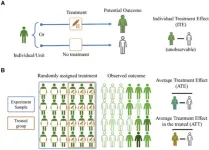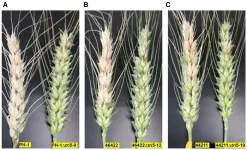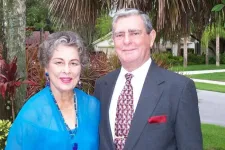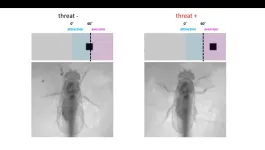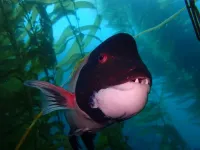(Press-News.org) Clean energy plans, including the U.S. Infrastructure Investment Act’s “Clean Hydrogen Road Map,” are counting on hydrogen as a fuel of the future. But current hydrogen separation technology is still falling short of efficiency and sustainability goals. As part of ongoing efforts to develop materials that could enable alternative energy sources, researchers in Drexel University’s College of Engineering have produced a titanium oxide nanofilament material that can harness sunlight to unlock the ubiquitous molecule’s potential as a fuel source.
The discovery offers an alternative to current methods that generate greenhouse gas and require a great deal of energy. Photocatalysis, a process that can split hydrogen from water using only sunlight, has been explored for several decades, but has remained a more distant consideration because the catalyst materials enabling the process can only survive it for a day or two, which limits its long-term efficiency and, as a result, its commercial viability.
Drexel’s group, led by College of Engineering researchers Michel Barsoum, PhD, and Hussein O. Badr, PhD, in collaboration with scientists from the National Institute of Materials Physics in Bucharest, Romania, recently reported its discovery of photocatalytic titanium oxide-based, one-dimensional nanofilament material that can help sunlight glean hydrogen from water for months at a time. Their article “Photo-stable, 1D-nanofilaments TiO2-based lepidocrocite for photocatalytic hydrogen production in water-methanol mixtures,” published in the journal Matter, presents a sustainable and affordable path for creating hydrogen fuel, according to the authors.
“Our titanium oxide one-dimensional nanofilaments photocatalyst showed activity that is substantially higher — by an order of magnitude — than its commercial titanium oxide counterpart,” Hussein said. “Moreover, our photocatalyst was found to be stable in water for 6 months — these results represent a new generation of photocatalysts that can finally launch the long-awaited transition of nanomaterials from lab to market.”
Barsoum’s group discovered hydroxides-derived nanostructures (HDNs) — the family of titanium oxide nanomaterials, to which the photocatalytic material belongs — two years ago, as it was working out a new process for making MXene materials, which Drexel researchers are exploring for a number of applications. Instead of using the standard, caustic hydrofluoric acid to chemically etch out the layered two-dimensional MXenes from a material called a MAX phase, the group used an aqueous solution of a common organic base, tetramethylammonium hydroxide.
But rather than producing a MXene, the reaction produced thin, fibrous titanium oxide-based strands — that the team would come to find possessed the ability to facilitate the chemical reaction that splits hydrogen out of water molecules when exposed to sunlight.
“Titanium-oxide materials have previously demonstrated photocatalytic abilities, so testing our new nanofilaments for this property was a natural part of our work,” he said. “But we did not expect to find that not only are they photocatalytic, but they are extremely stable and productive catalysts for hydrogen production from water-methanol mixtures.”
The group tested five photocatalyst materials — titanium oxide-based HDNs, derived from various low-cost and readily available precursor materials — and compared them to Evonik Aeroxide’s titanium oxide material, called P25, which is widely accepted as the photocatalyst material closest to commercial viability.
Each material was submerged in a water-methanol solution and exposed to ultraviolet-visible light produced by a tunable illuminator lamp that mimics the spectrum of the sun. The researchers measured both the amount of hydrogen produced and duration of activity in each reactor assembly, as well as the number of photons from the light that produced hydrogen when they interacted with the catalyst material — a metric for understanding the catalytic efficiency of each material.
They found that all five titanium oxide-based HDNs photocatalysts performed more efficiently at using sunlight to produce hydrogen than the P25 material. One of them, derived from binary titanium carbide, is 10 times more efficient than P25 at enabling photons to split off hydrogen from the water.
This improvement is quite significant on its own, the team reports, but an even more significant finding was that the material remained active after more than 180 days of exposure to the simulated sunlight.
“The fact that our materials appear to possibly be thermodynamically stable and photochemically active in water-methanol mixtures for extended durations cannot be overemphasized,” Hussein said. “Since our material is not costly to make, easy to scale up, and incredibly stable in water, its applications in various photocatalytic processes become worth exploring.”
The next step for the research is better understanding why the material behaves this way, so it can be further optimized as a photocatalyst. The team’s current theory posits that the one-dimensional nature and theoretical high surface area of the material contribute to its sustained activity, but additional testing is needed to confirm these suggestions.
The group is also working to find other additives, aside from methanol, to serve as “hole quenchers” — chemicals that prevent the water-splitting reaction from reversing course, which is a common occurrence due to the somewhat chaotic nature of photocatalytic reactions.
The results are so promising that the group has founded a green hydrogen startup around the technology and is working with the Drexel Office of Innovation and the National Science Foundation’s Innovation Corps to move toward commercializing it.
“We are very excited about the possibilities of this discovery,” Barsoum said. “The world needs massive new clean fuels that can supplant fossil fuels. We believe this material can unlock the potential of green hydrogen.”
In addition, the group is exploring a number of other applications for HDNs, including using them in batteries, solar cells, water purification and medical treatments. Their ability to be easily and safely produced in large quantities, sets HDNs apart from other nanomaterials, which opens them to a variety of possible uses, according to Hussein.
“Our HDNs family of nanostructures continue to impress the very different communities with whom we are collaborating. These titanium oxide nanofilaments can be used for number of applications including water purification, dye degradation, perovskite solar cells, lithium-ion and lithium-sulfur batteries, urea dialysis and breast cancer therapy, among many more.”
END
Drexel’s titanium oxide material lets sunlight drive green hydrogen production
Stable photocatalyst material opens new possibilities for harvesting hydrogen
2023-07-13
ELSE PRESS RELEASES FROM THIS DATE:
Advancing causal inference in clinical neuroscience research: a call for clarity
2023-07-13
A Perspective published in Volume 3 of the journal Psychoradiology, researchers from Shanghai Jiao Tong University confronted these challenges and advocates for more clarity and transparency in causal analyses. The review distinguishes between traditional statistical analysis and causal inference, highlighting the need for specific causal assumptions, like the Stable Unit Treatment Value Assumption (SUTVA).
Randomized controlled trials (RCTs) are considered the gold standard for estimating causal effects. The authors stress the importance of imitating RCTs in observational studies through quasi-experimental techniques, ...
Longevity biotech startup Gero demonstrates the power of quantum computing in drug design
2023-07-13
Gero, an AI-driven biotech focused on aging and longevity, has demonstrated the feasibility of applying quantum computing for drug design and generative chemistry, which now offers significant promise for the future of healthcare. The research, published in Scientific Reports, outlines how a hybrid quantum-classical machine-learning model was used to interface between classical and quantum computational devices with the goal of generating novel chemical structures for potential drugs — an industry first.
The research paper follows ...
Timing of turkey nesting may not shift with changing climate
2023-07-13
A new study suggests eastern wild turkeys in five southern U.S. states are unlikely to make meaningful changes in the timing of when they begin nesting, even under significant future climate change.
The findings suggest eastern wild turkeys (Meleagris gallopavo silvestris) could be vulnerable to shifts in climate, which could threaten the availability of their food sources, the amount of vegetation cover available to protect them from predators, and other factors.
“There are implications here for turkey populations ...
New toxin facilitates disease infection and spread in wheat
2023-07-13
Although wheat was among the first domesticated food crops, it remains a global dietary staple several millennia later. Grown on every continent except Antarctica, wheat is the second highest produced grain worldwide, with nearly 800,000 metric tons grown each year (Food and Agriculture Organization). However, a fungal pathogen named Fusarium graminearum causes the devastating disease Fusarium head blight (FHB) on wheat and contaminates grains with harmful toxins called trichothecenes. One such trichothecene, called deoxynivalenol (DON), is produced by most F. graminearum strains in the United States, and it is an essential virulence factor that increases the pathogen’s spread ...
FAU receives $11.5 million gift to combat life-threating illness, amyloidosis
2023-07-13
Currently, there is no cure for amyloidosis, a life-threatening disease that can be present throughout the body, including the heart, kidneys, liver and brain. The most common localized form of amyloidosis, which is seen significantly more often, is in the brain. Cerebral amyloidosis, when symptomatic, usually manifests in one of two ways: in Alzheimer’s disease and related dementias and in brain bleeds, which have consequences such as a stroke.
Because amyloidosis does not affect a specific organ, unraveling the underlying cause of amyloid fibril creation – a hallmark ...
Schmidt Marine Technology Partners announces recipients of $3.5 million global sustainable fisheries initiative
2023-07-13
SAN FRANCISCO—Schmidt Marine Technology Partners, a program of the Schmidt Family Foundation, has awarded $3.5 million in grants to ten organizations and universities in seven countries for the development of new tools and innovations that will improve the sustainability of global fisheries, the program announced today.
“Tens of millions of jobs around the world depend on fisheries, and seafood is the primary protein source for 3 billion people,” said Wendy Schmidt, president and co-founder of the Schmidt Family Foundation. “The innovators chosen to receive these grants are ensuring that fishers and ...
New material could hold key to reducing energy consumption in computers and electronics
2023-07-13
A University of Minnesota Twin Cities team has, for the first time, synthesized a thin film of a unique topological semimetal material that has the potential to generate more computing power and memory storage while using significantly less energy. The researchers were also able to closely study the material, leading to some important findings about the physics behind its unique properties.
The study is published in Nature Communications, a peer-reviewed scientific journal that covers the natural sciences and engineering.
As evidenced by the United States’ recent CHIPS and Science Act, there is a growing need to increase semiconductor manufacturing ...
Artificially grown ‘mini-brains’ without animal components bring opportunities for neuroscience
2023-07-13
Researchers at University of Michigan developed a method to produce artificially grown miniature brains — called human brain organoids — free of animal cells that could greatly improve the way neurodegenerative conditions are studied and, eventually, treated.
Over the last decade of researching neurologic diseases, scientists have explored the use of human brain organoids as an alternative to mouse models. These self-assembled, 3D tissues derived from embryonic or pluripotent stem cells ...
Fear is in the eye of the beholder
2023-07-13
Averting our eyes from things that scare us may be due to a specific cluster of neurons in a visual region of the brain, according to new research at the University of Tokyo. Researchers found that in fruit fly brains, these neurons release a chemical called tachykinin which appears to control the fly’s movement to avoid facing a potential threat. Fruit fly brains can offer a useful analogy for larger mammals, so this research may help us better understand our own human reactions to scary situations and phobias. Next, the team want to find out how these ...
Multiple ecosystems in hot water after marine heatwave surges across the Pacific
2023-07-13
(Santa Barbara, Calif.) – Rising ocean temperatures are sweeping the seas, breaking records and creating problematic conditions for marine life. Unlike heatwaves on land, periods of abrupt ocean warming can surge for months or years. Around the world these ‘marine heatwaves’ have led to mass species mortality and displacement events, economic declines and habitat loss. New research reveals that even areas of the ocean protected from fishing are still vulnerable to these extreme events fueled by climate change.
A study published today in Global Change Biology, led by researchers at UC Santa ...
LAST 30 PRESS RELEASES:
Satellite communication systems: the future of 5G/6G connectivity
Space computing power networks: a new frontier for satellite technologies
Experiments advance potential of protein that makes hydrogen sulfide as a therapeutic target for Alzheimer’s disease
Examining private equity’s role in fertility care
Current Molecular Pharmacology achieves a landmark: real-time CiteScore advances to 7.2
Skeletal muscle epigenetic clocks developed using postmortem tissue from an Asian population
Estimating unemployment rates with social media data
Climate policies can backfire by eroding “green” values, study finds
Too much screen time too soon? A*STAR study links infant screen exposure to brain changes and teen anxiety
Global psychiatry mourns Professor Dan Stein, visionary who transformed mental health science across Africa and beyond
KIST develops eco-friendly palladium recovery technology to safeguard resource security
Statins significantly reduce mortality risk for adults with diabetes, regardless of cardiovascular risk
Brain immune cells may drive more damage in females than males with Alzheimer’s
Evidence-based recommendations empower clinicians to manage epilepsy in pregnancy
Fungus turns bark beetles’ defenses against them
There are new antivirals being tested for herpesviruses. Scientists now know how they work
CDI scientist, colleagues author review of global burden of fungus Candida auris
How does stroke influence speech comprehension?
B cells transiently unlock their plasticity, risking lymphoma development
Advanced AI dodel predicts spoken language outcomes in deaf children after cochlear implants
Multimodal imaging-based cerebral blood flow prediction model development in simulated microgravity
Accelerated streaming subgraph matching framework is faster, more robust, and scalable
Gestational diabetes rose every year in the US since 2016
OHSU researchers find breast cancer drug boosts leukemia treatment
Fear and medical misinformation regarding risk of progression or recurrence among patients with breast cancer
Glucagonlike peptide-1 receptor agonists and asthma risk in adolescents with obesity
Reviving dormant immunity: Millimeter waves reprogram the immunosuppressive microenvironment to potentiate immunotherapy without obvious side effects
Safety decision-making for autonomous vehicles integrating passenger physiological states by fNIRS
Fires could emit more air pollution than previously estimated
A new way to map how cells choose their fate
[Press-News.org] Drexel’s titanium oxide material lets sunlight drive green hydrogen productionStable photocatalyst material opens new possibilities for harvesting hydrogen

